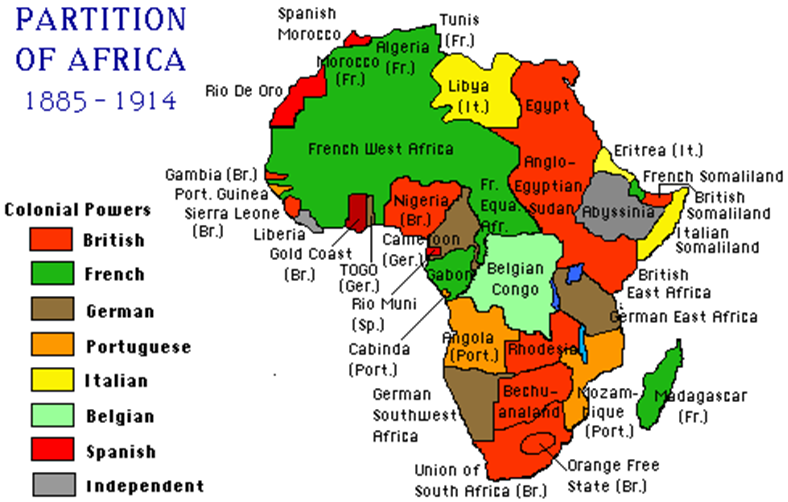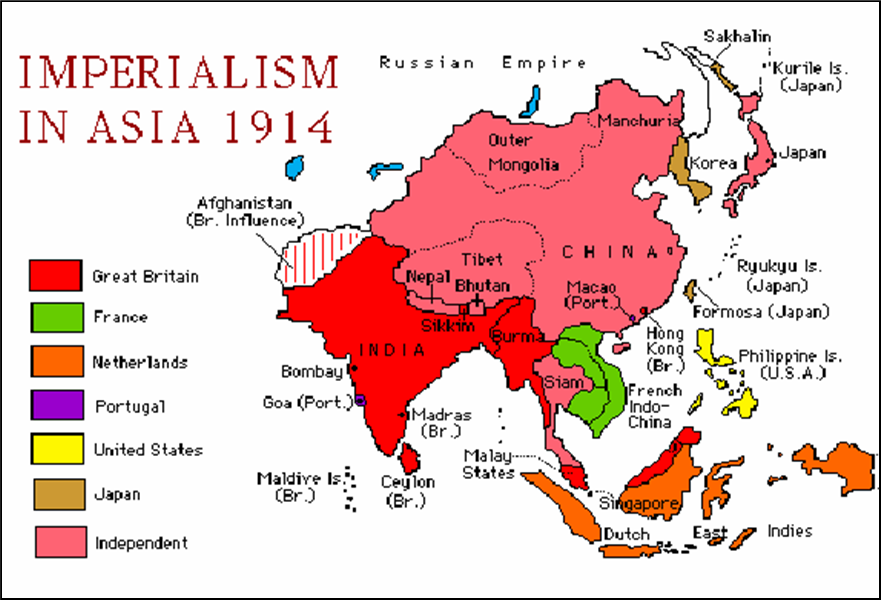


THE BERLIN CONFERENCE ON AFRICA
1884-
Acknowledgements
Conference:
published in Die Gartenlaube (The
Garden Arbor), a prominent German weekly magazine of this
time, 1884, artist unknown. Map (Africa):
licensed under Creative Commons. Author: TUBS – commons,
wikimedia.org. Map (Africa): licensed
under Creative Commons –
maryslezak.wikispaces.com/Research+and+Bibliography. Bismarck: French cartoon, published 1885, artist unknown. Map (Partition of Africa): from ontrack-
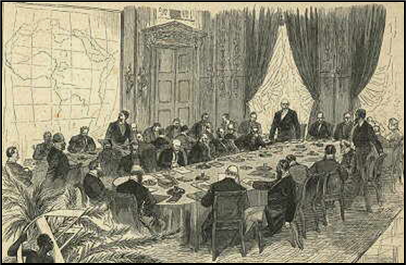 xxxxxOstensibly,
the Berlin Conference of 1884 was
convened by the German Chancellor Otto von Bismarck to find a
peaceful settlement to a dispute which had arisen over the
colonial exploitation of The Congo. This vast region in central
Africa was one of the last areas on the continent to be explored
and opened up, and it was claimed in whole or in part by three
contenders: France, Portugal, and Leopold II, King of the
Belgians. Once this dispute had been settled, however, the
Conference set about the more important task of deciding on the
colonial partition of Africa or, put in less prosaic terms, which
countries should have what in the grab for the “dark continent”.
For the fourteen nations represented, all economically developed,
there was a great deal to be gained in Africa by way of new
markets, valuable minerals and natural products.
xxxxxOstensibly,
the Berlin Conference of 1884 was
convened by the German Chancellor Otto von Bismarck to find a
peaceful settlement to a dispute which had arisen over the
colonial exploitation of The Congo. This vast region in central
Africa was one of the last areas on the continent to be explored
and opened up, and it was claimed in whole or in part by three
contenders: France, Portugal, and Leopold II, King of the
Belgians. Once this dispute had been settled, however, the
Conference set about the more important task of deciding on the
colonial partition of Africa or, put in less prosaic terms, which
countries should have what in the grab for the “dark continent”.
For the fourteen nations represented, all economically developed,
there was a great deal to be gained in Africa by way of new
markets, valuable minerals and natural products.
xxxxxAs we shall see (1885), the King of the Belgians, Leopold II, conceived the idea of establishing a colony in Africa in the late 1870s. Between 1879 and 1884 he commissioned the explorer Henry Stanley (of Doctor Livingstone fame) to set up a number of stations along the Congo River, and to make treaties with the local African rulers to gain sovereignty over their areas. Andxto give political respectability to his claim, Leopold established the International Congo Society in 1879, charged with bringing science, civilisation and Christianity to the native population, encouraging trade, and taking military action against the slave trade. At this time, however, both France and Portugal also claimed territorial rights in the Congo region. In 1881 a French marine officer named Pierre de Brazza, exploring in the Western Congo, had raised the French flag over the newly established settlement of Brazzaville, and three years later the Portuguese, claiming the area around the mouth of the Congo by right of earlier agreements (dating from the discoveries of Diogo Cão in 1482 (E4)) had made a treaty with the British to deny Leopold and the French access to the Atlantic.
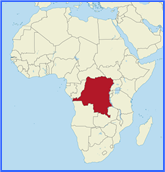
 xxxxxAfter much political wrangling, the Conference settled
the dispute over the Congo. By way of compensation, the French
were given some 250,000 square miles on the north bank of the
Congo River, and the Portuguese were granted an extension of
350,000 square miles to Angola, their colony to the south. But the
bulk of this vast region -
xxxxxAfter much political wrangling, the Conference settled
the dispute over the Congo. By way of compensation, the French
were given some 250,000 square miles on the north bank of the
Congo River, and the Portuguese were granted an extension of
350,000 square miles to Angola, their colony to the south. But the
bulk of this vast region -
xxxxxBut Belgium,
via its king, was not the only European country to have ambitions
in Africa. In 1881 the French had occupied Tunisia, and the
following year Italy had occupied Eritrea, and Britain had
virtually taken over the control of Egypt. This new phase of
colonial activity alarmed Bismarck. Germany, now a major power,
was seeking new markets for its growing industries, and time and
places were fast running out. South America had a determined
guardian in the shape of the United States, and much of Asia had
been seized by others, notably the British, the French and the
Dutch. He saw an international conference on Africa as the best
means of regulating colonisation and trade on that continent, and
making sure, at the same time, that Germany also acquired a place
-
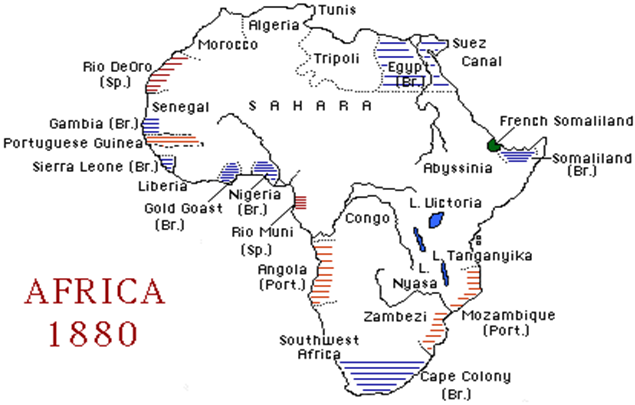 xxxxxUntil the beginning of the 1880s the European powers
had generally confined their settlement in Africa to the building
of staging and trading posts along the coast. At that time, only
about 10% of the continent was under direct European control, the
main areas being Algeria under the French, Cape Colony and Natal
under the British, and the Portuguese colony of Angola. By 1914,
however, (see map below) well over 90% of the continent was under
European rule. Only Liberia and Ethiopia remained fully
independent.
xxxxxUntil the beginning of the 1880s the European powers
had generally confined their settlement in Africa to the building
of staging and trading posts along the coast. At that time, only
about 10% of the continent was under direct European control, the
main areas being Algeria under the French, Cape Colony and Natal
under the British, and the Portuguese colony of Angola. By 1914,
however, (see map below) well over 90% of the continent was under
European rule. Only Liberia and Ethiopia remained fully
independent.
xxxxxIt was in anticipation of this violent “scramble for Africa” that in 1885 the Berlin Conference laid down the ground rules for future colonisation. In order to be recognised by the international community, the new colonies had to be legally owned, and effectively occupied, administered and defended. And also required was a firm undertaking to work for the suppression of the slave trade. These were laudable requirements, but at ground level the prime aim of each colonial power was the exploitation of the mineral and natural resources that the new territories offered. In reality, the welfare of the native population was not considered, nor were any tribal leaders consulted during the partitioning. The continent was simply carved up along geometric lines, imposed boundaries that paid no attention to language or tribal affiliation. It was a recipe for ethnic conflict, and proved to be so when the countries began to gain their independence in the years following the Second World War of 1939 to 1945.
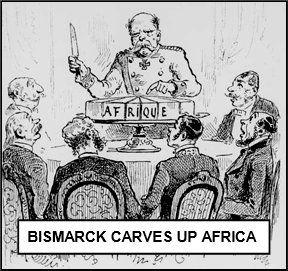 xxxxxApart from King Leopold, the major countries to
benefit from this grab of Africa were Great Britain, France,
Germany and Portugal (see map below). Over the next 30 years
(1884-
xxxxxApart from King Leopold, the major countries to
benefit from this grab of Africa were Great Britain, France,
Germany and Portugal (see map below). Over the next 30 years
(1884-
Including:
Colonies in Asia 1914

Vc-
xxxxxOutwardly,
the Berlin Conference was convened by the German Chancellor Otto
von Bismarck in 1884
to settle a dispute which had arisen over claims to the Congo in
central Africa. Leopold II, king of the Belgians, as we shall see
(1885), was
anxious to take personal charge of this vast region, but two other
nations, France and Portugal, laid claims to parts of this area.
After some wrangling, Leopold was granted a huge colony named The
Congo Free State. This matter resolved, the Conference then turned
its attention to the colonisation of Africa as a whole. In
addition to the take-
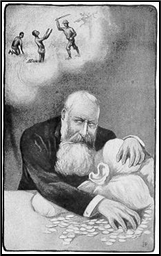 xxxxxAs we shall see, despite Leopold’s promises to bring
civilization to the Congo by missionaries and economic
development, nothing was done to improve the living conditions of
the native people. Once in power in 1885, he embarked on a brutal and systematic campaign of
exploitation, carried out by his own private army and the
concession companies which he allowed in to control the lucrative
trade in ivory and wild rubber. As a result, the colony became a
vast labour camp in which torture, mass killing and widespread
mutilation were routinely used in order to maximize production. In
the early years of the century, however, ugly rumours began to
circulate about Leopold’s barbaric regime. Eventually, in 1904 the
publication of the Casement Report, initiated by Britain, exposed
the atrocities being committed, and four years later the Belgian
government was obliged to bow to international pressure and take
over the administration of the “Belgian Congo”.
xxxxxAs we shall see, despite Leopold’s promises to bring
civilization to the Congo by missionaries and economic
development, nothing was done to improve the living conditions of
the native people. Once in power in 1885, he embarked on a brutal and systematic campaign of
exploitation, carried out by his own private army and the
concession companies which he allowed in to control the lucrative
trade in ivory and wild rubber. As a result, the colony became a
vast labour camp in which torture, mass killing and widespread
mutilation were routinely used in order to maximize production. In
the early years of the century, however, ugly rumours began to
circulate about Leopold’s barbaric regime. Eventually, in 1904 the
publication of the Casement Report, initiated by Britain, exposed
the atrocities being committed, and four years later the Belgian
government was obliged to bow to international pressure and take
over the administration of the “Belgian Congo”.
xxxxxBut this
brutal system of exploitation, motivated by greed and enforced by
terror, was by no means confined to the Congo. Like Leopold, the
other colonial powers were also bent on exploiting the riches of
their territories, and were often quite prepared to use barbaric
methods to achieve their aim. Explorers like David Livingstone
might well have been motivated by the three Cs – Commerce,
Christianity and Civilisation, but there was a fourth C -
xxxxxSix countries
held colonial territories in Asia in
1914 (see map below).
Britain was by
far the largest landowner, controlling Ceylon (1815), Singapore
(1819), Burma (1824), Hong Kong (1841), India (1858), Bhutan
(1864), Malaya (1867), Sarawak, Brunei and North Borneo (1888),
and Sikkim (1888). France
completed the occupation of Indo China -
